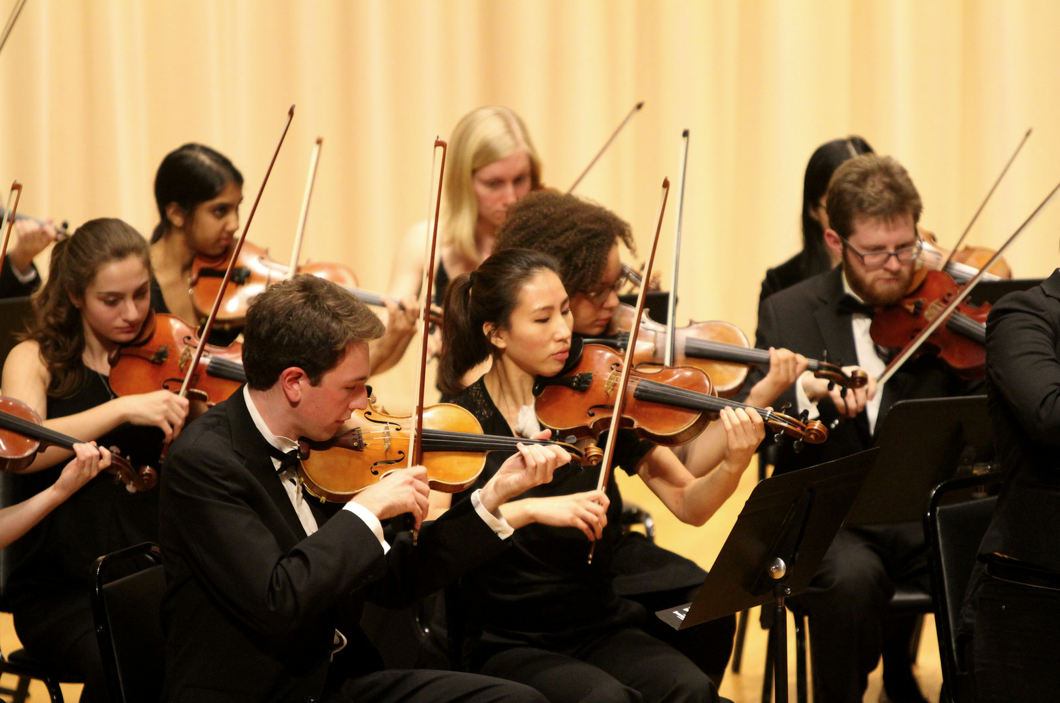

The Amherst Symphony Orchestra opened its season on Saturday, Sept. 27 with a fresh and inspiring performance. The season preview concert, dedicated to the Amherst class of 2018, was titled “Vienna: City of Music, City of Dreams” and directed by Mark Swanson.
What set this concert apart from previous performances was the overwhelming amount of first-year musicians involved. The audience entered Buckley Recital Hall to see only about half the orchestra members sitting in their seats, practicing their parts. The remaining chairs onstage were empty, to be filled with new students. Only when they entered did the orchestra gain its full power and confidence. The 70-some member orchestra prepared five pieces over the course of three and a half weeks. They treated the audience to one and a half hours of music, a selection that “every musician has dreamed of playing,” said concertmaster Matthew Chow ’18.
The performance began with Back’s “Toccata & Fugue in D Minor” delivered in a way far different than what the piece is usually known for. Arranged by Leopold Stokowski in the 20th century, this composition has a specific modern feel. The famous organ piece was adapted for a symphonic setting instead of the grating keyboard instrument, making it seem less archaic and much more accessible.
Johann Strauss, Jr.’s “By the Beautiful Blue Danube,” a piece that was the unofficial Austrian anthem, followed the opening of the show. During this composition, the gestures of the conductor gracefully led the orchestra from quiet melodies to tense preparations for a final breath of relief and joy.
Afterwards was an excerpt from the suite to Richard Strauss’s opera “The Knight of the Rose.” The contrast between the soft, lolling romantic portions and the almost-discordant thunderstorm at the conclusion of the piece produced a powerful dynamic. Just when it seemed that the music couldn’t get louder, it did. As the powerful notes hypnotized the audience, conductor Mark Swanson dropped into a squat and the symphony quieted accordingly, jolting the audience from its trance.
The penultimate excerpt from Movement II of Gustav Mahler’s “Tempo di menuetto” was a joy to listen to. Judging from the musicians’ faces, it was also a joy to play. As the final notes fell into a profound silence, the orchestra members jointly smiled — either from a job well done or from their instruments’ power.
The concert concluded with Brahms’ “Movement IV: Allegro con spirit” from “Symphony #2 in D Major.” This piece felt as though the instruments were engaged in a tense discussion that created melodies both familiar and revitalized through young talent and new hands.
It was those young talents that made the concert so memorable. Between pieces, Swanson noted that the total amount of years of lessons taken by the orchestra all together amounts to 670 years. Even the performers themselves seem to be constantly surprised by each other’s abilities.
“This is a really challenging repertoire and we sound really good, even [when] sight reading! I was totally impressed, and I am still totally impressed,” said flutist Krista Goebel ’18, one of the first-year representatives of the orchestra. Many first-years came from disjointed, cutthroat and impersonal high school orchestras. They were not expecting the Amherst Symphony Orchestra’s fun, relaxed, nonjudgmental attitude.
Part of this positive vibe comes from the director and conductor. Mark Swanson is unanimously described as passionate, demanding and respectful. He respects other commitments and other hobbies. Although his passion and energy is intense and awe-inspiring from the audience’s point of view, it “was difficult to take seriously the first few rehearsals,” said bassoonist Eunnie Lee ’18. “He tries to disguise himself as a college student. It’s been such a positive experience. He goes ‘conductor-snarky’ when people screw up, but he can quickly build up positivity after.” He has many methods of transforming the efforts of a huge group of people into a united sound. He offers sectional master classes outside rehearsals so woodwinds, brass or violins can play together w form a cohesive unit.
“It’s the sectionals that really put together our piece,” said violinist Grant Park ’18. Additionally, during rehearsals, Swanson stands in places other than the central position, which forces each section to listen to the other ones, uniting the orchestra as a whole.
But this coherency was not created overnight. Five pieces over three and a half weeks makes for a hectic, breakneck rehearsal pace. One of the pieces was introduced a week before the concert and could be polished to be audience-ready.
The audience appreciated this show of passion, force and unity in music with a standing ovation lasting several minutes. “That was cool, really cool,” said Tim Adams UMass ’17 after the final bow. Other audience members agreed.
“Orchestral music [opens] your heart,” said Iris Zhang ’18.
Luckily, this concert was only a preview. The Amherst Symphony Orchestra’s 2014-2015 season has officially begun. The group plays next on Friday, Oct. 24 at 8:30 p.m. It will perform a program entitled “Signature Series #1: The Three B’s: Back, Beethoven, and Brahms” in Buckley Recital Hall.